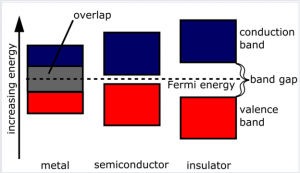Write Three Definitions
Introduction: The goal of this task is to write three definitions of a term in three different styles: parenthetical, sentence, and expanded. Through this assignment, the student will gain an appreciation for how different audiences and purposes require different forms of definition. Moreover, the student will learn the significance of defining terms clearly in technical writing.
Term: semiconductor
Target audience and Situation: First-year students in Electrical Materials Class. I assume my students have some basic knowledge of science.
Parenthetical Definition
A semiconductor is an electrical material (a special type of material that is used to conduct electricity in electronic devices such as transistors, diodes, and integrated circuits) that has unique properties.
Sentence Definition
A semiconductor is an electrical material that has a conductivity level that is between that of a conductor and an insulator, making it suitable for use in electronic devices such as transistors, diodes, and integrated circuits.
Expanded Definition
A semiconductor is a material that has an electrical conductivity level that falls between that of a conductor and an insulator. One of the key features of a semiconductor is its ability to control its conductivity through the process of doping, where impurities such as boron or phosphorus are added to the material. This makes it possible to modify the material’s properties, such as its electrical conductivity, and use it in a wide range of electronic devices. Semiconductors are used as switches and amplifiers in many types of electronics, including transistors, diodes, and integrated circuits.
What are the key features of a semiconductor?
One of the key features of a semiconductor is its ability to control its conductivity achieved by the doping process, meaning that impurities such as boron or phosphorus can be added to control its conductivity. This makes it possible to modify the material’s properties, such as its electrical conductivity, and to use it in a wide range of electronic devices. Semiconductors are used as switches and amplifiers in many types of electronics, including transistors, diodes, and integrated circuits.
What is conductivity and how is it determined?
The conductivity of a material is how easily electricity can flow through it. In a semiconductor, the conductivity can be adjusted by creating an energy bandgap. The bandgap is a range of energy levels where electrons in the material cannot occupy. When impurities are added to the material, it changes the number of electrons available, which changes the conductivity. The wider the bandgap, the less conductive the material is. The size of the bandgap and the number of electrons determine the conductivity of a semiconductor, and it can be modified to be used in different electronic devices.
What kinds of materials can be semiconductors?
Semiconductors are made from elements such as silicon and germanium, and the specific material used depends on the application for which it will be used. Silicon, for example, is the most commonly used material for semiconductors, due to its abundance and its ability to be doped to form both n-type and p-type semiconductors.

Figure 1: A bandgap diagram showing the different sizes of band gaps for conductors, semiconductors, and insulators.
Works Cited:
“Band gap.” Prof. Jason Donev from the University of Calgary. Retrieved February 03, 2023, from https://energyeducation.ca/encyclopedia/Band_gap
“Electrical resistivity and conductivity.” (2023, January 13). Retrieved February 03, 2023, from https://en.wikipedia.org/wiki/Electrical_resistivity_and_conductivity
“Semiconductor.” (2023, February 01). Retrieved February 03, 2023, from https://en.wikipedia.org/wiki/Semiconductor
“Semiconductor.” Encyclopædia Britannica. Retrieved February 03, 2023, from www.britannica.com/science/semiconductor
Leave a Reply